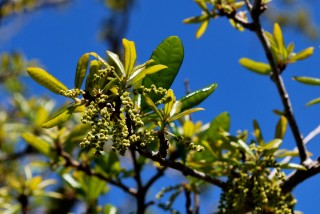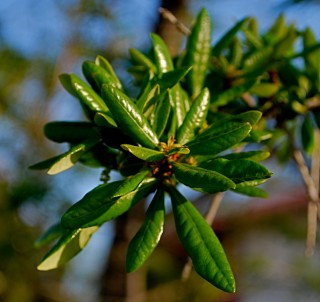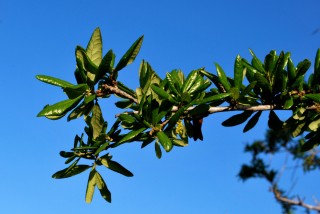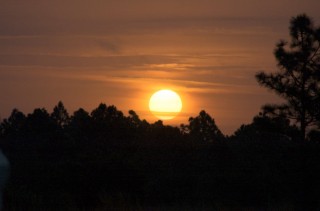It’s been a little over three years now since we tore out our old landscaping, with its mostly exotic plants, and replaced it with plants native to our area: live oak, cocoplum, saw palmetto, myrsine and marlberry, bitterbush, firebush, wild coffee, coral bean and necklace pod, spicewood, buttonwood, crabwood and ironwood, stoppers of all sorts (Spanish, Simpson’s, twinberry). In all, we brought in some 85 native species of trees, shrubs, and herbaceous plants, and a few noninvasive exotics like our Dutchman’s Pipe vine (complemented by the native maypop vine). The very first spring after we had the native plants installed, we were visited by a Connecticut Warbler (Oporornis agilis), which really let us know that we were onto something:
Since then we haven’t been blessed with many warblers; a very aggressive family of mockingbirds has taken up residence in our yard and it’s the rare bird indeed that can find comfort here. But the mockingbirds have a sweet, cheery song, and it’s wonderful fun to hear them singing from our little oak trees out front and trying to spot them. [It’s mildly less wonderful to hear their loud cheery song outside our open windows at 3 a.m., but that doesn’t last long, and it’s nice to know that there is some wildlife left in our urban existence…]
We’ve also got a couple of families of cardinals in the area, and we see and hear them frequently in our back yard. And the family of spot-breasted orioles down the street is still going strong, although they didn’t appreciate losing our giant bird of paradise plant in the redo; they stop in on our oak trees from time to time, but they don’t seem to appreciate our youthful landscape yet. Maybe after it grows up…
Since April started, it’s been getting harder and harder to find the mockers on their perches in our trees, because the oaks have been leafing out:
With all the rain we’d been getting over the dry season, I was a bit surprised that these trees waited for the traditional start of spring to begin doing their thing. I guess they respond more to photoperiod than they do to availability of water. Makes sense, I suppose, for these long-lived species. They don’t have to respond rapidly to highly variable resources like rainfall. They’re in for the long haul, and for the long haul, you want to hitch your wagon to the sun. Clouds come and go, rainy seasons can be good or bad, but the sun, you can count on.
One factoid I find interesting about oaks in general is that they flower and leaf out at just about the same time and, as the pictures above show, it’s calendrical spring. With most other trees, the flowers precede the leaves, but the oak doesn’t bother with that. Why not? There must be some adaptive reason for this. What is it?
[Alternate hypothesis: the oaks are responding not just to photoperiod, but to temperature. We had an unusually long and cool winter, and it might be the return to near-normal temperatures that is prompting this April leafout. Any thoughts?]






Your question seemed like a good chance to exercise my Google-fu (which has been failing me with distressing regularity).
I think I found an answer in this PDF from the University of Tennessee:
Another interesting thing I read there:
Elsewhere while searching I accidentally learned a couple other things:
And I’d heard of the ‘mast year’ expression before but never knew what it referred to:
So I’m curious, does (or will) the wild coffee produce usable beans?
Thanks for the links, Oroboros! Mast years I remember from (I think) good old Marty Stauffer and his Wild America show on PBS. I know he talked about mast as a food source for many of our larger mammals.
Re wild coffee: its specific name is Psychotria nervosa, so one might indeed be tempted to do something with the beans. I wouldn’t recommend it, though. It’s nothing like arabica coffee, and doesn’t have any caffeine…